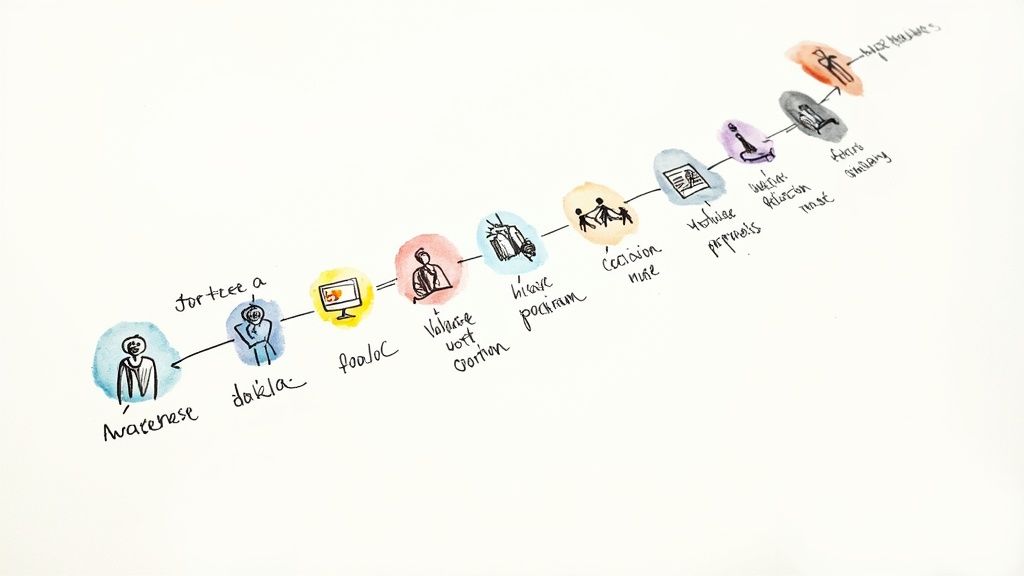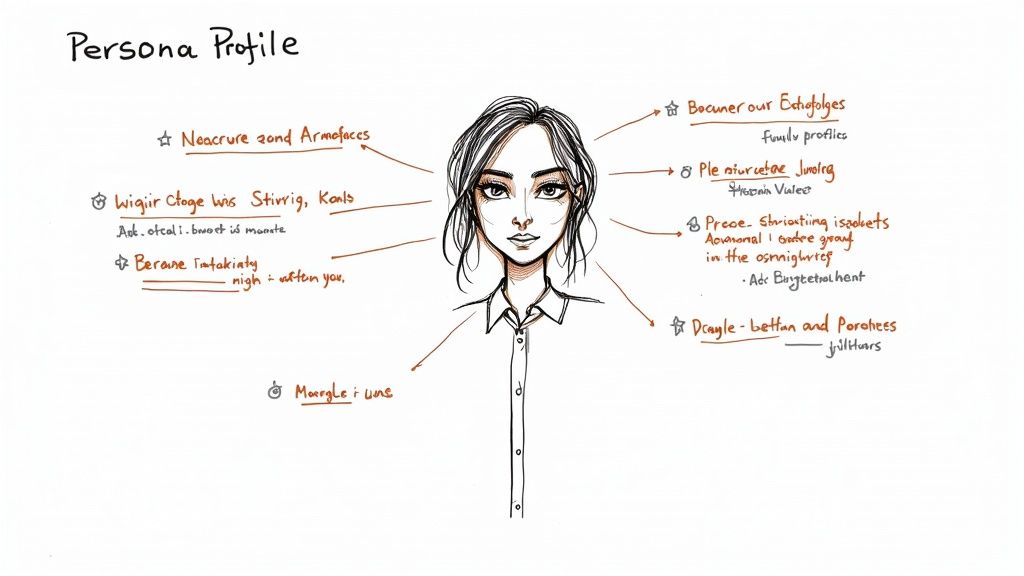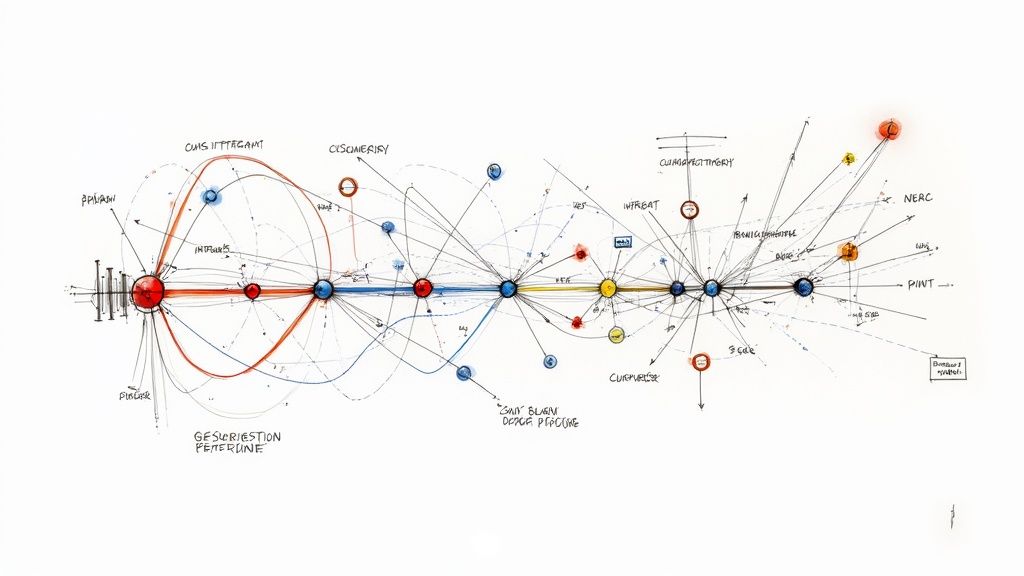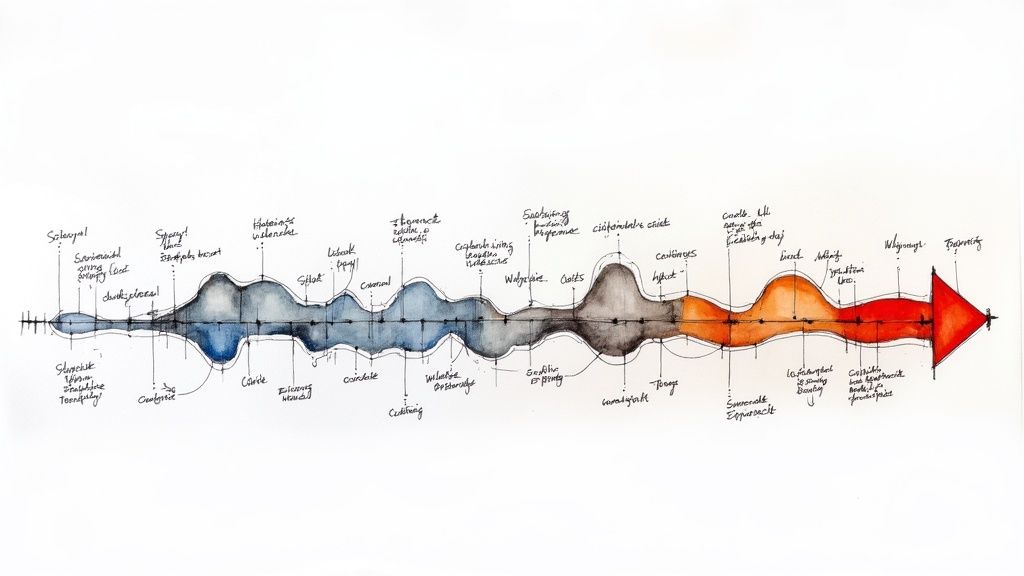10 Powerful Customer Journey Mapping Examples That Drive Real Results
Breaking Down Success Stories in Customer Journey Mapping

Real examples show how mapping customer journeys improves business results. When companies take time to understand exactly how customers interact with their brand at each step, they often see major gains in engagement and sales. Let's look at some compelling cases that demonstrate the practical value of this approach.
Healthcare Technology: Shifting Focus to the Influencer
A healthcare tech company learned this lesson firsthand, achieving a 43% boost in engagement after mapping their customer journey. While they initially built their platform around patients, the mapping process revealed something unexpected - caregivers were actually driving most decisions. By redesigning their platform with caregivers in mind, adding clearer navigation, educational content, and better ways to communicate, they saw engagement numbers climb significantly. This shows how identifying the real decision-makers can transform results.
Retirement Homes: Targeting the Decision-Makers
Similarly, a retirement home referral service found success by mapping their customers' path to purchase. Their research showed that adult children, not seniors themselves, typically made the final choice about retirement homes. Armed with this insight, they adjusted their marketing to address the adult children's main concerns - highlighting safety features, social activities, and quality of care. This more targeted approach led directly to more conversions.
Digital Diaries: Uncovering Hidden Needs
Some companies go deeper by having customers keep digital diaries of their experiences over time. This gives rich, detailed data about how people actually use products and services day-to-day. For instance, these diaries might reveal that customers get stuck on certain website features or feel frustrated during checkout. Traditional surveys often miss these kind of specific pain points that can make or break the customer experience.
Spotify's Music-Sharing Journey: Optimizing for Engagement
Spotify offers another great example of effective journey mapping. The music streaming service carefully analyzed how users share songs with friends, looking at each step from opening the app to completing a share. This detailed view helped them spot and fix friction points in the sharing process. Their data-driven improvements to the sharing experience have helped fuel both user growth and retention. The lesson? Even successful companies can benefit from understanding exactly how customers use specific features.
Digital Innovation: Inside Spotify's Journey Mapping Revolution

Spotify learned early on that truly understanding how people use their service was key to growing their business. Instead of just focusing on the technical aspects of music streaming, they wanted to deeply understand the full user experience. This led them to map out every step of how people interact with their platform - from downloading the app for the first time to creating playlists and sharing songs with friends.
Mapping the Onboarding Experience
The team paid special attention to what happens when someone first uses Spotify. They looked closely at each step new users take - signing up, making their first playlist, finding music they like, and connecting with friends on the platform. By watching how people moved through these early moments, they spotted places where users got stuck or confused. This helped them simplify the design and make everything more intuitive, especially for newcomers.
Enhancing Music Discovery
Getting people to stick around meant making it easy and fun to find new music they'll love. The team studied how users explored music and interacted with their playlists. They paid attention to what made people excited about discovering new songs and artists. This deep understanding helped them create better recommendations and custom playlists that matched what each person likes. The more they learned about how people found and enjoyed music, the more engaging the platform became.
Optimizing Social Sharing
Music is more fun when shared with friends, so Spotify looked carefully at how people share songs. They examined everything from how users pick songs to share, to which sharing methods they prefer, to what happens when the recipient gets the shared track. This detailed look revealed some surprising pain points - like confusing share menus and missing connections to popular social platforms. By fixing these issues, they made sharing music as natural as listening to it.
Measuring the Impact: Data-Driven Results
All these improvements weren't just guesswork - Spotify tracked specific numbers to see what worked. They measured things like how long people stayed on the platform, how often they came back, and how satisfied they were overall. For example, when they made sharing easier, they could see an immediate jump in how many songs people shared with friends. This focus on real results showed the clear value of understanding the user journey and helped make journey mapping a core part of how Spotify operates. Their success shows how paying close attention to user experience can lead to real business growth.
Amazon's Customer-Centric Journey Mapping Strategy
Building on the journey mapping practices pioneered by companies like Spotify, Amazon has developed its own powerful approach to understanding and improving the customer experience. The company's success stems from carefully mapping out every interaction a customer has - from first discovering a product through post-purchase support. This detailed mapping helps Amazon create specific journey frameworks for different product categories and customer types.
Identifying Key Touchpoints and Measuring Satisfaction
Amazon pays close attention to key moments in the customer journey and carefully tracks satisfaction at each step. Take the example of someone buying a laptop - they might browse listings, compare specs, read reviews, add items to cart, complete checkout, track shipping, and potentially contact support. Amazon monitors specific metrics like conversion rates, time spent on pages, and customer feedback to spot any friction points. This data helps them quickly identify and fix problems to keep customers happy.
Personalization and Feedback Integration
By catching issues early, Amazon can solve problems before they affect more customers. The company actively uses feedback from product reviews, support conversations, and return reasons to improve the experience. When multiple customers mention that checkout feels complicated, for example, Amazon can quickly make it simpler. This constant loop of gathering and acting on feedback helps Amazon keep making the shopping experience better.
Continuous Improvement and Predictive Analysis
Amazon also uses journey mapping to get ahead of potential problems. Their analysis of historical data helps spot likely bottlenecks - for instance, if they see delivery delays are probable during certain periods, they can let customers know in advance. This proactive communication helps set realistic expectations and prevent frustration. The company knows customer needs and behaviors change over time, so they regularly update their journey maps with new touchpoints and insights. This commitment to constantly learning from data and customer feedback is central to how Amazon maintains its edge in online retail.
Using Digital Diaries for Deep Customer Insights

Digital diaries give businesses a more personal window into how customers actually experience their products and services, going beyond what traditional surveys and analytics can reveal. By having customers document their interactions over time, companies gather rich details and context that help identify overlooked problems and opportunities. For instance, when a retirement home referral service used digital diaries, they discovered that adult children were making most placement decisions, not seniors themselves. This insight led them to completely shift their marketing approach to better reach the true decision-makers.
Setting Up an Effective Digital Diary Program
To create a successful digital diary program, focus on these key areas:
- Pick the Right Tools: Choose a platform that makes it easy for participants to share text, images and videos. Make sure it works well on mobile devices so people can record experiences as they happen. The system should also keep data secure and help organize findings.
- Create Clear Prompts: Well-designed questions guide participants to share meaningful insights. Mix open-ended questions that encourage detailed responses with specific tasks like taking photos during product use. A food delivery app might ask users to document each step of ordering with screenshots and descriptions.
- Make Sense of the Data: With so many responses to analyze, you need good tools for finding patterns. Look for features that help tag and categorize responses to spot important themes and turn findings into action.
Digital Diaries in Action: Real Examples
Here's how different organizations have used digital diaries to map and improve their customer journeys:
- Healthcare: A provider tracked patients' recovery experiences after surgery through digital diaries. This revealed both emotional challenges and practical difficulties they faced, helping improve post-surgery care and communication.
- Banking: One bank studied how customers used their mobile app through digital diaries. The insights directly shaped a redesign that made the app more intuitive and user-friendly.
These examples show how digital diaries can reveal valuable insights across different industries.
Turning Customer Stories into Business Results
Digital diaries do more than just collect stories - they provide a structured way to gather authentic feedback throughout the entire customer journey. This detailed understanding helps companies pinpoint exactly where and how to improve. The result? Higher customer satisfaction, stronger loyalty, and better business performance. By learning from real examples like those above, businesses can see the concrete benefits of digital diaries and implement them effectively in their own customer research programs.
Modern Tools Reshaping Journey Mapping Success

The success of customer journey mapping heavily depends on using the right tools and technologies. By selecting tools that match their specific goals and needs, companies can gain deeper insights into customer behavior and create more effective journey maps. Let's explore how modern solutions are changing the way businesses approach journey mapping.
Leveraging Advanced Analytics and AI
Journey mapping tools have evolved far beyond simple visualization software. The best tools now include powerful analytics capabilities that help companies truly understand customer behavior through data. For instance, AI analysis can spot patterns that humans might miss, like unexpected points of friction in the customer experience. Major companies like Amazon use this kind of analysis to continually improve their sales process and customer experience. Modern tools also make it possible to track customers across different channels - from website visits to social media interactions to in-store purchases - giving businesses a complete picture of the customer journey. Spotify demonstrates this well in how they track and optimize the music sharing experience across their app and social platforms.
Choosing the Right Tool for Your Needs
With the journey mapping software market expected to reach $48.5 billion by 2032 (growing at 16.3% annually), businesses have many options to choose from. This growth shows how important journey mapping has become for improving customer experience. When evaluating tools, focus on these key factors:
- Integration Capabilities: The tool should work smoothly with your existing systems like CRM platforms and analytics tools to create a complete view of customer interactions
- Collaboration Features: Since journey mapping involves input from different teams, look for tools that make it easy to work together and share insights
- Visualization Options: Choose tools that can present journey maps in clear, engaging ways that make sense to everyone involved
- Customization and Flexibility: Your tool should adapt to your specific business processes and needs
- Scalability: Make sure the tool can grow along with your business
- Budget: Consider both immediate and long-term costs. Cloud-based options (growing at 16% annually) often cost less than installed software since they don't require special infrastructure
Building a Comprehensive Journey Mapping System
Most successful companies don't rely on just one tool - they combine several to create a complete journey mapping system. They might use specialized mapping software to create visual journey maps while using separate tools for data analysis and gathering customer feedback. This approach lets them get the best features from each tool while building a more effective overall system. It also helps companies map both current customer experiences and plan improvements for the future. By carefully choosing and combining the right tools, businesses can create journey maps that lead to real improvements in customer satisfaction and loyalty.
Turning Journey Mapping Insights Into Revenue Growth
A well-crafted customer journey map is a starting point, not the destination. The true test lies in using these insights to drive real business outcomes. Just like an architect translates blueprints into a physical building, businesses must convert journey mapping insights into concrete actions that improve customer experiences and boost revenue. Success requires both a strategic plan and a systematic approach to implementation.
Prioritizing Improvements and Measuring Success
When faced with multiple opportunities for improvement, smart prioritization becomes essential. Some changes will deliver far greater impact than others - both in customer satisfaction and revenue gains. To identify the highest-value opportunities, evaluate each potential improvement based on three key factors: how severely it affects customers, how many customers it impacts, and what return on investment it could generate.
For instance, if your journey map reveals that 40% of customers abandon purchases during checkout due to confusing payment options, addressing this issue should take precedence over fixing minor inconveniences that affect only a small segment of users. This targeted approach helps focus resources where they'll have the biggest impact.
Measuring results is equally critical. Select specific key performance indicators (KPIs) that align with your journey mapping goals. If reducing customer churn is the objective, track metrics like retention rates and customer lifetime value. Regular monitoring of these KPIs helps validate whether changes are working as intended and guides necessary adjustments. This creates a feedback loop that drives continuous refinement of the customer experience.
Scaling Journey Mapping Across Your Organization
For journey mapping to deliver lasting value, it must become part of your organization's DNA rather than existing as an isolated initiative. Building cross-functional teams is key to this integration. When representatives from marketing, sales, customer service, and product development collaborate, they develop a shared understanding of customer needs and work in harmony toward common goals.
The insights from journey mapping can then naturally flow into various business activities - from shaping new product features to improving service protocols and refining marketing messages. A software company might use journey map findings to simplify their onboarding process while simultaneously updating help documentation and training support staff on common customer pain points.
Getting executive support is crucial for long-term success. Leaders need to see concrete evidence of how journey mapping drives business results. Share specific examples where journey mapping insights led to measurable improvements in customer satisfaction and revenue. Back these stories with data showing the bottom-line impact. Keep stakeholders informed through regular updates that highlight progress and wins.
By combining these implementation strategies with lessons learned from successful companies like Spotify and Amazon, businesses can create a clear path from journey mapping insights to revenue growth. The key is maintaining focus on actionable improvements while building organizational alignment around customer needs.
Ready to improve your customer experience and grow revenue? Explore how AI-powered chatbots can help. Create your custom chatbot today!


